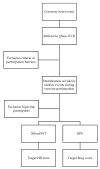Cardiac Rehabilitation Based on the Walking Test and Telerehabilitation Improved Cardiorespiratory Fitness in People Diagnosed with Coronary Heart Disease during the COVID-19 Pandemic
- PMID: 33668304
- PMCID: PMC7956401
- DOI: 10.3390/ijerph18052241
Cardiac Rehabilitation Based on the Walking Test and Telerehabilitation Improved Cardiorespiratory Fitness in People Diagnosed with Coronary Heart Disease during the COVID-19 Pandemic
Abstract
This study investigated an alternative home-based cardiac telerehabilitation model in consideration of the recommendations for the COVID-19 quarantine of people diagnosed with coronary heart disease (CHD). We hypothesized that using a 200 m fast walking test (200 mFWT) and telerehabilitation would create an effective alternative cardiac rehabilitation (CR) intervention that could improve cardiorespiratory fitness. Participants (n = 19, mean age 60.4 ± 9.6) of the 8-week intervention performed regular physical exercise at the target heart rate zone determined by calculations based on the 200 mFWT results. In our study, the participants were supervised using telerehabilitation. A total of 84% of participants completed the 8-week intervention. No adverse events were reported during telerehabilitation. The study participants noted a significant improvement (p < 0.001) in cardiorespiratory fitness expressed by an 8% reduction in the walking test time (Δ 8.8 ± 5.9 s). Home-based telerehabilitation based on 200 mFWT effectively increased the cardiorespiratory fitness in people with CHD with a low to moderate cardiovascular risk. This was a novel approach in CR during the COVID-19 pandemic. As research in this area is justified, this paper may serve as an alternative method of providing healthcare during the COVID-19 pandemic and as a basis for further upcoming randomized controlled trials.
Keywords: COVID-19; cardiac rehabilitation; cardiac telerehabilitation; cardiorespiratory fitness; coronary heart disease; heart rate monitor; physical exercise.
Conflict of interest statement
The authors declare no conflict of interest.
Similar articles
-
Efficacy, efficiency and safety of a cardiac telerehabilitation programme using wearable sensors in patients with coronary heart disease: the TELEWEAR-CR study protocol.BMJ Open. 2022 Jun 23;12(6):e059945. doi: 10.1136/bmjopen-2021-059945. BMJ Open. 2022. PMID: 35738643 Free PMC article.
-
Long-term exercise effects after cardiac telerehabilitation in patients with coronary artery disease: 1-year follow-up results of the randomized study.Eur J Phys Rehabil Med. 2021 Oct;57(5):807-814. doi: 10.23736/S1973-9087.21.06653-3. Epub 2021 Feb 23. Eur J Phys Rehabil Med. 2021. PMID: 33619944 Clinical Trial.
-
Effect of home-based high-intensity interval training using telerehabilitation among coronary heart disease patients.Medicine (Baltimore). 2020 Nov 20;99(47):e23126. doi: 10.1097/MD.0000000000023126. Medicine (Baltimore). 2020. PMID: 33217814 Free PMC article.
-
Effectiveness of home-based cardiac telerehabilitation as an alternative to Phase 2 cardiac rehabilitation of coronary heart disease: a systematic review and meta-analysis.Eur J Prev Cardiol. 2022 May 25;29(7):1017-1043. doi: 10.1093/eurjpc/zwab106. Eur J Prev Cardiol. 2022. PMID: 34254118 Free PMC article.
-
Cardiovascular telerehabilitation improves functional capacity, cardiorespiratory fitness and quality of life in older adults: A systematic review and meta-analysis.J Telemed Telecare. 2024 Sep;30(8):1238-1248. doi: 10.1177/1357633X221137626. Epub 2022 Dec 5. J Telemed Telecare. 2024. PMID: 36469017
Cited by
-
Validity and reliability of automated treadmill six-minute walk test in patients entering exercise-based cardiac rehabilitation.Ann Med. 2023;55(2):2304664. doi: 10.1080/07853890.2024.2304664. Epub 2024 Jan 17. Ann Med. 2023. PMID: 38233732 Free PMC article.
-
Physiotherapists' Adoption and Perceptions of Tele-Rehabilitation for Cardiorespiratory Care in Response to COVID-19.Physiother Can. 2024 May 8;76(2):211-217. doi: 10.3138/ptc-2021-0135. eCollection 2024 May. Physiother Can. 2024. PMID: 38725596 Free PMC article.
-
Efficacy, efficiency and safety of a cardiac telerehabilitation programme using wearable sensors in patients with coronary heart disease: the TELEWEAR-CR study protocol.BMJ Open. 2022 Jun 23;12(6):e059945. doi: 10.1136/bmjopen-2021-059945. BMJ Open. 2022. PMID: 35738643 Free PMC article.
-
Telerehabilitation: Exploring the Untapped Potential.Cureus. 2024 Apr 1;16(4):e57405. doi: 10.7759/cureus.57405. eCollection 2024 Apr. Cureus. 2024. PMID: 38694631 Free PMC article.
-
COVID-19 and Cardiovascular Disease: a Global Perspective.Curr Cardiol Rep. 2021 Aug 19;23(10):135. doi: 10.1007/s11886-021-01566-4. Curr Cardiol Rep. 2021. PMID: 34410538 Free PMC article. Review.
References
-
- Wilkins E., Wilson L., Wickramasinghe K., Bhatnagar P., Leal J., Luengo-Fernandez R., Burns R., Rayner M., Townsend N. European Cardiovascular Disease Statistics 2017. European Heart Network; 2017. [(accessed on 4 January 2021)]. pp. 1–192. Available online: http://www.ehnheart.org/images/CVD-statistics-report-August-2017.pdf.
-
- Ambrosetti M., Abreu A., Corrà U., Davos C.H., Hansen D., Frederix I., Iliou M.C., Pedretti R.F., Schmid J.P., Vigorito C., et al. Secondary Prevention through Comprehensive Cardiovascular Rehabilitation: From Knowledge to Implementation. 2020 Update. A Position Paper from the Secondary Prevention and Rehabilitation Section of the European Association of Preventive Cardiology. Eur. J. Prev. Cardiol. 2020;27:1–42. doi: 10.1177/2047487320913379. - DOI - PubMed
Publication types
MeSH terms
Grants and funding
LinkOut - more resources
Full Text Sources
Other Literature Sources
Medical
Research Materials


